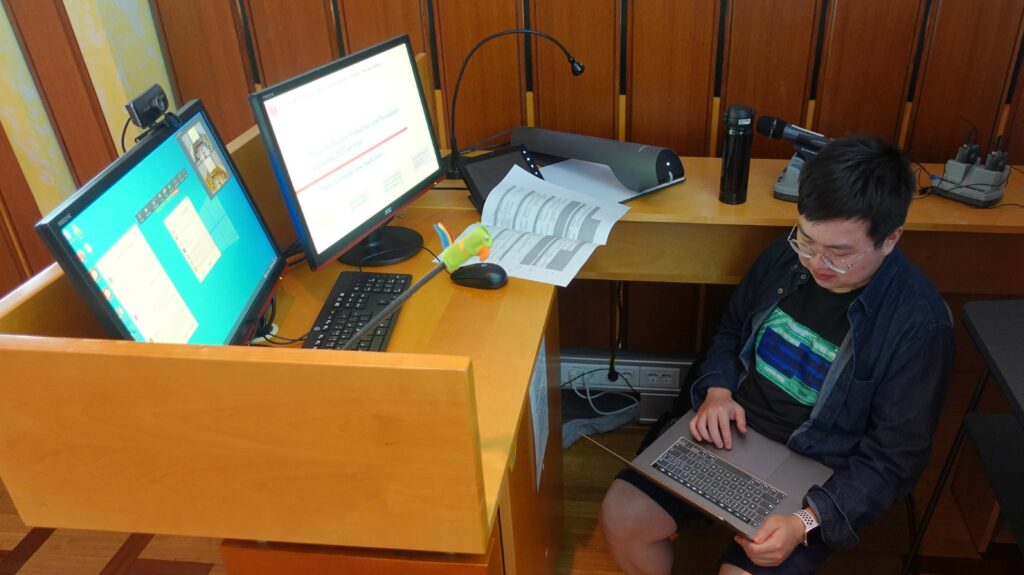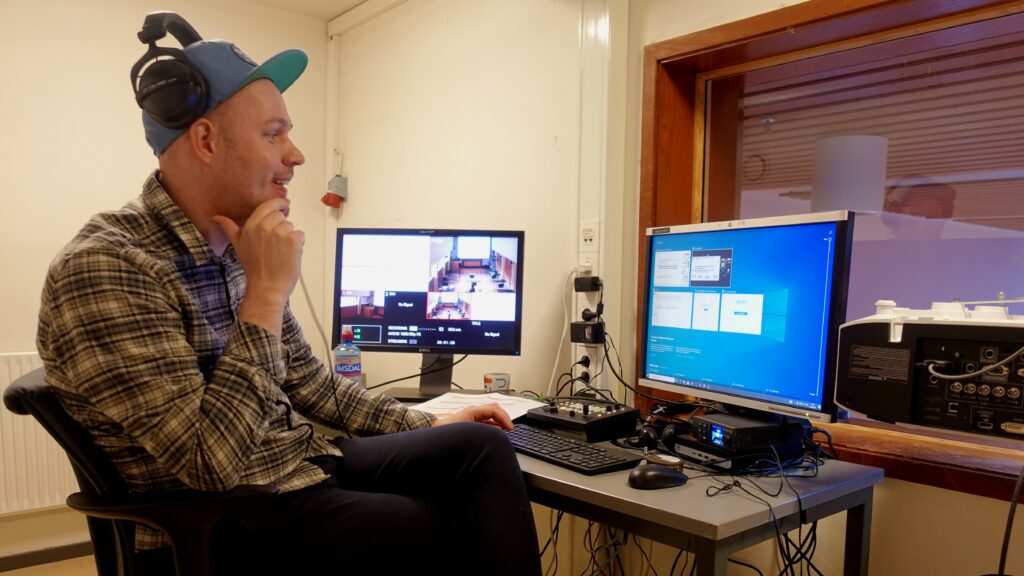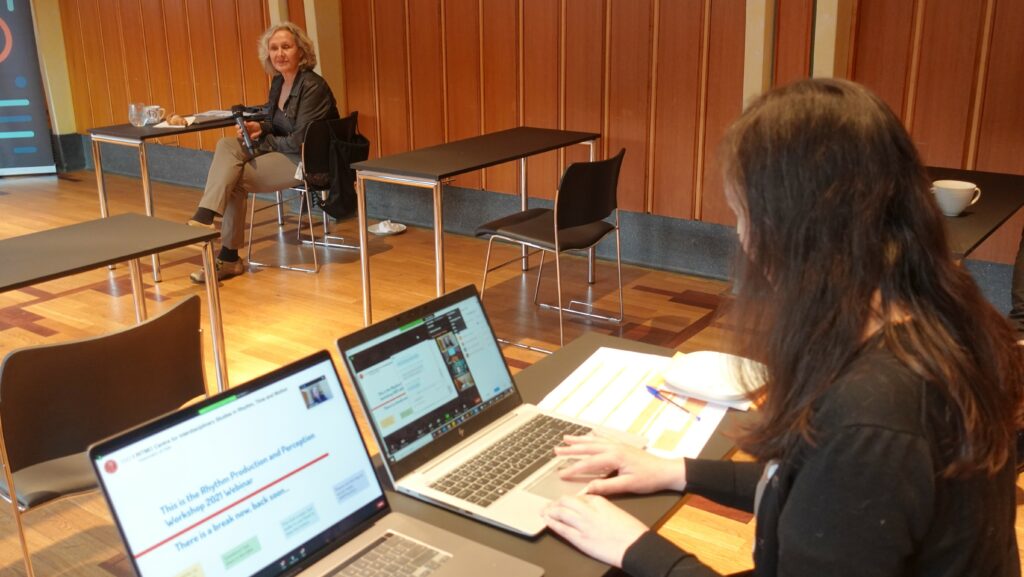I have been involved in running some Zoom Webinars over the last year, culminating with the Rhythm Production and Perception Workshop 2021 this week. I have written a general blog post about the production. Here I will write a little more about some lessons learned on running large Zoom Webinars.
In previous Webinars, such as the RITMO Seminars by Rebecca Fiebrink and Sean Gallagher, I ran everything from my office. These were completely online events, based on each person sitting with their own laptop. This is where the Zoom Webinar solution shines.
Things become more complex once you try to run a hybrid event, where some people are online and others are on-site. Then you need to combine methods for video production and streaming with those of a streamlined video conferencing solution. It is doable but quite tricky.

The production of the RPPW Webinar involved four people: myself as “director”, RITMO admin Marit Furunes as “Zoom captain”, and two MCT students, Thomas Anda and Wenbo Yi as “Zoom station managers”. We could probably have done it with three people, but given that other things were going on simultaneously, I am happy we decided to have four people involved. In the following, I will describe each person’s role.
Zoom station 1
The first Zoom station, RITMO 1, was operated by Wenbo Yi. He was sitting behind the lecture desk in the hall, equipped with one desktop PC with two screens. The right screen was split to be shown with a projector on the wall. This was the screen that showed displays when there were breaks, and so on.

There are three cameras connected to the PC: one front-facing that we used for the moderator of the keynote presentations, one next to the screen on the wall that showed a close-up of conference chair Anne Danielsen during the introductions, and one in the back of the hall that showed the whole space.
There are four microphones connected to the PC and the PA system in the hall. One on the desk that was used for the keynote moderation. We only used one of the wireless microphones, a handheld one that Anne used during her introductions.
The nice thing about Zoom is that it is easy for a person to turn on and off cameras and microphones. However, this is designed around the concept that you are sitting in front of your computer. When you are standing in the middle of the room, someone else will need to click. That was the job of Wenbo. He switched between cameras and microphones and turned on and off slides.
Zoom station 2
The second Zoom station, RITMO 2, was operated by Thomas Anda, sitting in the control room behind the hall. He was controlling a station that was originally designed as a regular video streaming setup. This includes two remote-controlled PTZ cameras connected to a video mixer. For regular streams, we would have tapped the audio and video from the auditorium and made a mix to be streamed to, for example, YouTube. Now, we mainly used one of the PTZ cameras to display the general picture from the hall.

The main job of Thomas was to playback all the 100 pre-recorded videos. We had a separate, ethernet-cabled PC for this task connected to the Zoom Webinar and shared the screen. The videos were cued in VLC, with poster images inserted between the videos. During our testing of this setup, we discovered the uneven sound level of the video files, which led to a normalization procedure for all of them.
In theory, we could have played the video files from RITMO station 1. However, both Wenbo and Thomas had plenty of things to think about, so it would have been hard to do it all alone. Also, having two stations allowed for having two camera views and also added redundancy for the stream.
Zoom captain station
The third station was controlled by our “Zoom captain”, Marit Furunes. She served as the main host of the Webinar most of the time and was responsible for promoting and de-promoting people to panellists during the conference.

It is possible to set up panels in advance, but that requires separate Zoom Webinars and individualized invitation e-mails. We have experienced in the past that people often forget about these e-mails, so we decided to just have one Zoom Webinar for the entire conference and rather move people in and out of the panels manually. That required some manual work by Mari, but it also meant that she was in full control of who could talk in each session.
She was also in charge of turning on and off people’s video and sound, and ensuring that the final streamed looked fine.
Director station
I was sitting next to Marit, controlling the “director station”. I was mainly checking that things were running as they should, but I also served as a backup for Marit when she took breaks. In between, I also tweeted some highlights, replied to e-mails that came in, and commented on things in Slack.

Monitoring and control
Together, the four of us involved in the production managed to create a nice-looking result. There were some glitches, but in general, things went as planned. The most challenging part of working with a Webinar-based setup is the lack of control and monitoring. What we have learned is that “what you see is not what you get”. We never really understood what to click on to get the final result we wanted. For example, we often had to click back and forth between the “gallery” and “speaker” view to get the desired result.
Also, as a host, you can turn off other cameras, but you cannot turn them on, only ask for the person to turn them on. That makes sense in many ways. After all, you should not be allowed to turn on the camera of another person remotely. However, as a production tool in an auditorium, this was cumbersome. It happened that Marit and I wanted to turn on the main video camera in the hall (from RITMO 2) or the front-facing camera (from RITMO 1). But we were not allowed to do this. Instead, we had to request that Thomas or Wenbo could turn on the cameras.
Summing up
The Zoom Webinar function was clearly made for a traditional video-conferencing-like setup. For that it also works very well. As described above, we managed to make it work quite well also in a hybrid setup. However, this required a 4-person strong team and 5 computers. The challenge was that we never really felt that we were completely in control of things. Also, we could not properly monitor the different signals.
The alternative would be a regular video streaming solution, based on video and audio mixers. That would have given us a much higher control of the final stream, including good monitoring. It would have required more equipment (that we have) but not necessarily more people. We would have lost out on some of the Zoom functionality, though, like the Q&A functionality that works very well.
Next time I am doing something like this, I would try to run a stream-based setup instead. Panellists could then come in through a Zoom Room, which could be mixed into a stream using either our hardware video mixer or a software mixer like OBS. Time will tell if that ends up being better or worse.